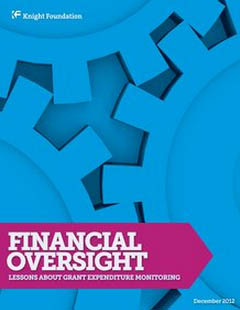
Webinar: Best practices for funders in financial oversight
RELATED LINKs
Archive: GEM Webinar (39 min., Webex.com archived event)
At Knight Foundation, we value working with grantees who are willing to take big risks and experiment in smart, well thought out ways. Equally as valuable to us are the tools that help effectively manage and evaluate the impact of those risks on the implementation of grants. That’s why in 2006, when the foundation had distributed nearly $1 billion and was supporting increasingly complex, multi-year grants, Knight began to develop a tool for real-time expenditure monitoring called the Grant Expenditure Monitoring Guide (GEM).
Now, we are eager to share the GEM tool in an April 5 webinar, where funders can learn how to improve fiscal oversight and strengthen relationships with grantees.
The foundation started the GEM program in collaboration with specialists at accounting firm KPMG. In the last five years, KPMG has reviewed more than 230 grants valued at over $482 million. As a result, we’ve helped recover $8.2 million, funds grantees were able to use toward their original objectives.
How GEM Program has evolved
At the start of the program, the GEM review was done on any new grant over $1 million. Those reviews were mainly “one-size-fits-all” solutions where a team from KPMG visited the grantee’s offices to review their books and records.
In 2011, Knight conducted independent assessments on the impact and operations of the GEM program. Based on the feedback we received from grantees and staff as well as the evaluators, Knight now uses a risk-based approach. The program starts with program staff completing an assessment of business risks during the development of a grant. This review follows a standard form that assigns a risk score to a number of factors.
We see the risk scoring sheet as a tool to assist program staff in standardizing how they analyze the implementation risk of a grant. Since it is shared on Knight’s internal grant management system, it also allows other staff with similar grants to learn from another program director’s analysis. The results of completing the sheet are two-fold: we get a quantified risk score and a thoughtful and documented analysis of implementation risk.
We’ve designed the form to be relatively short (less than 20 questions) and simple to complete (taking about 15 minutes) in order to reduce the administrative burden on staff.
Based on the risk score and program staff’s judgment, one of three types of GEMs can be scheduled:
Once completed, KPMG prepares a report that details their observations, if any. Knight program staff works with the grantee to respond to the observations and implement any necessary corrections.
Impact
The GEM program has impacted operations in three major ways:
- Improved financial oversight
- Supported foundation staff
- Strengthened grant operations.
As I mentioned above, since we started the program, GEM reviews have resulted in over $8.2 million being recovered for the purposes of their grants. To be clear, these funds were not returned to Knight but rather were spent by the grantees on the original objectives of the grant.
The GEM’s have also become, in the words of one Knight program director a “valuable grant management resource.” It has provided financial expertise for program staff and improved communication with grantees.
Because the GEM review goes beyond a typical audit by examining governance structures, business sustainability plans and other elements of an organization’s operations many grantees credit them with strengthening their operations. For example, almost half of surveyed grantees found the review experience valuable and noted that the KPMG report contained useful insights.
What we’ve learned
Knight has made the following changes because of this process. We:
- Begin financial oversight during grant development.
- Review grants based on risk, not size.
- Customize reviews to fit the need.
- Evaluate grantee controls and procedures, not just expenses.
- Communicate early and often with grantees.
- Develop a consistent approach to finalize reviews.
- Encourage program staff participation.
- Designate the right person to manage the program.
We appreciate the opportunity to share our experiences with the GEM program with you. If you’d like more detail on the program, access our report here and join the webinar on April 5.
By Juan Martinez, vice president/chief financial officer and treasurer at Knight Foundation